Season of Rot / Eric S. Brown
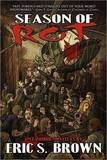 Permuted Press / July 2009
Permuted Press / July 2009
Reviewed by: Michele Lee
Eric S. Brown's Season of Rot is a collection of five zombie novellas that from the first page demonstrates how well-versed Brown is in the zombie genre. In scene after scene, readers will find good guys and bad guys, women and children, all trying to survive the undead plague while holed up in hospitals, military bases and even luxury cruise ships converted for war against the undead.
What's hard to find is a true sense of storytelling in any of Brown's offerings.
The difference here is in the distinction between middle-of-the-road horror tales and the kinds of stories that capture imaginations. Brown wields a mean zombie — be it fast or slow, intelligent or mindless, holding a rocket launcher or its own insides. But while the settings and origins of the zombie hordes change from story to story, the plots don’t. Readers are repeatedly told what's happening, flatly informed of the interchangeable traits and circumstances of the characters, and at times even told only about plot advancements through mini-flashbacks after switches in point of view.
Plot points function less like a quick zombie ambush here and more like the stumbling undead that readers will be able to make out from a distance. Season of Rot is also crippled by the blatantly cringe-worthy science, particularly bad in “The Wave” where some mysterious alien malfunction millions of light years away causes a wave of radiation that hits Earth, causing all electronics to fail – even batteries – shatters, and sends a splinter (of a radiation wave) back out to the sun where it makes our favorite star explode. This wave damages technology and fries human brains, but doesn't damage plants or other animals at all. The logic and science are so glaringly horrible that two pages after explaining all electricity-based things are non-functional, a character uses not one, but two, electronic keypad-secured doors only to find scientists running simulations of the wave impact on large TV screens inside.
The worst problem, for this reviewer, is the disconnect between the characters and the reader. These stories are populated with horrible situations, tragic circumstances, and sacrifices, but misfortunes that seem rushed, almost like Brown is speeding us past an accident scene rather than making the reader a paramedic taking full assessment of the situation. The characters are largely interchangeable and their loss and pain is generically sad and tragic, but there is no expansion on these emotions past the words used to inform the reader.
If you want zombies, large scale gun battles, and heroic last stands, then Season of Rot is your book. But if you're looking for good stories – spun out of real people and emotions and more than mere words – then keep looking.
Purchase Season of Rot by Eric S. Brown.
Sha’Daa: Tales of the Apocalypse / Created by Michael H. Hanson and Edited by Edward F. McKeown
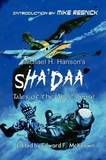 Altered Dimensions / May 2009
Altered Dimensions / May 2009
Reviewed by: Joan Turner
Sha’Daa: Tales of the Apocalypse is a unique anthology/novel hybrid built upon the concept that once every ten-thousand years, the walls between our world and that of the demons thin and monsters are able to gain entrance and attack. Creator Michael H. Hanson acknowledges that the end-of-days theme owns much to horror greats who have come before, and the book is dedicated to Lovecraft, Poe, Bloch and others. Hanson’s approach, however, is uniquely his own, and while the reader may be vaguely remind of the Lovecraftain mythos, the stories are new, contemporary, and equally spellbinding.
Hanson wrote the entire outline as well as the interludes between the eleven “chapters” or stories. Certain characters who reappear throughout the book – the most fascinating of which is Johnny the Salesman, a time traveler who always arrives with just the right trade to give humans a chance – also connect the eleven stories that comprise the volume.
Johnny’s real identity and purpose remain a mystery until near the end.
The theme of each chapter or story is the same. When the walls between worlds thin, evil monsters attempt to break through to destroy humankind. They can only be stopped by a Champaign, however unlikely, who is able to defeat the demon charge. Yet within this framework, individual authors offer stories in a wide variety of styles and approaches, ranging from humor to extreme horror.
The same sense of awe and wonder that inspired readers to suspend disbelief and made Lovecraft’s fiction so popular and enduring is evident in many of the stories in Sha’Daa.
Editor Edward McKeown’s “The Dive” is a case in point. New York sewer workers investigate what may be a hollow space in a city tunnel near where bodies of transit cops were found and discover uncharted tunnels and a horde of demons out for blood.
“Lava Lovers” by Wilson “Pete” Marsh pits Agenor, son of Poseidon, against the demon invasion.
In “The Way of the Warrior” by Arthur Sanchez, a brave apprentice may find a way to outwit a demon with a little help from the Salesman.
“Dixie Chrononauts” by Duncan R. MacMaster finds a group of Confederate soldier Civil War re-enactors fighting a battle for their lives.
“Prana” by Sha’Daa creator Hanson and “The Salesman” by Rob Adams tie up loose ends and leave only the Epilogue to bring the volume to its conclusion.
Michael Hanson’s Sha’Daa is a unique concept, written in a form that falls somewhere between an anthology and a novel and packed with first rate stories that are fresh, exciting and leave the reader wanting more. Fortunately, Hanson promises a forthcoming sequel — Sha’Daa: Last Call.
Sha’Daa: Tales of the Apocalypse is an enjoyable read from beginning to end. Highly recommended.
Purchase Sha'Daa: Tales of the Apocalypse created by Michael H. Hanson and edited by Edward F. McKeown.
“For Her” / Michael West
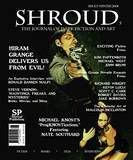 from Shroud Magazine #5 / Winter 2009
from Shroud Magazine #5 / Winter 2009
Reviewed by: Anthony J. Rapino
Anyone who has ever fantasized about having a threesome has likely also considered the possible outcomes of such an act. When Jeff’s girlfriend, Brooke, suggests they go to a brothel, predictably his initial reaction is one of glee.
It isn’t until they are driving to the Bunny Hop Ranch that Jeff considers the possible reasons for – and consequences of – Brooke’s arrangement. Does she want to leave him for someone else? Is she dissatisfied with him and craving a more substantially endowed lover? Amazingly, he even considers the coming experience as a gift for Brooke that he must endure, a way to satisfy her without losing her. Pushing these thoughts aside, Jeff convinces himself that even if this fantasy was Brooke’s idea, there’s no harm in enjoying it as well.
Upon arrival, they meet Brooke’s chosen prostitute, Xilomen. Jeff is amazed by her beauty and can see why Brooke selected her. But as they retreat to their room, it soon becomes clear that there is one far stranger consequence to this fantasy that Jeff never considered.
Like a good whisky, West’s prose goes down smooth and fiery all at once. Never does one stumble across awkward phrasing in this purposeful story, making the execution and final reveal all the sweeter. And even as the atmosphere changes and horror sets in, the shift is never forced. When your copy of Shroud arrives, turn first to West’s “For Her,” and start the issue out right.
Purchase Shroud Magazine #5 with “For Her” by Michael West.
Necrotic Tissue (Issue 7) / Edited by R. Scott McCoy
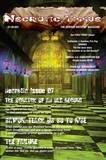 Stygian Publishing / July 2009
Stygian Publishing / July 2009
Reviewed by: Rich Ristow
Genre publishing is filled with start-up-failures. One sees this all the time on high-traffic message boards. A would-be editor starts a thread, proclaiming their brand spanking new periodical will change the face of horror, that they’re the new wave, that they’re up and coming, that the “mainstream” is keeping down aspiring writers, that the “five cents a word payment” is a tyranny mandated by the HWA, that they’re only going to pay half a penny per word, and so on. Meanwhile, the product they’re offering is usually passé and unoriginal. The stories themselves have editing problems and strike a potential reader as retreads and poor imitations of more successful writers. The problem with these magazines and editors is simple: They started with wholly unrealistic promises and expectations, and publically, they have no other place to go, other than to exit stage right with egg on their face.
Of course, there is no set way to build a successful publishing venture. Different people find different ways and methods that work for them. There, is, however, one generally shared tactic. For example, there’s the recent edition of R. Scott McCoy’s journal Necrotic Tissue. McCoy follows the “start small and slowly build model” that has worked for some. Necrotic Tissue began as an online PDF magazine, where issues were free to download. As of their July issue, they’ve changed to a printed, trade paperback format. Their schedule promises quarterly issues. But, a change in format is not the sole niche-carving tactic R. Scott McCoy has employed. The journal has sought to build its own identity.
First, there’s not a lot of non-fiction. Most periodicals have a review section; Necrotic Tissue doesn’t. There are no essays on the latest novels, no reviews of theatrical of direct-to-DVD horror films. There are no commentaries on the publishing industry, or even fact-filled columns on the history of horror in culture. There are only a handful of editorials, some of which cover writing, and some of which take care of “editorial house cleaning.” One gets the impression that they’re in the pages more for clarification than anything else. That’s fine, and in fact, it’s in keeping with R. Scott McCoy’s direction.
Necrotic Tissue employs a tagline on its cover: “The Horror Writers Magazine.” That could imply a couple of things. First, it’s about craft of writing horror fiction, but the lack of essays instantly dispels that notion. So, one is left with the alternate interpretation, one McCoy likely intended: Necrotic Tissue is meant as a venue for horror writers to showcase their work. The lack of reviews, in this regard, strips down the focus to a more singular vision. By not publishing essays and reviews, Necrotic Tissue has more space for fiction.
The stories are split by two separate aesthetics. There’s traditional horror, as evidenced by Horace James’s “El Dorado” – the dead come back to life in the form of reanimated skeletons, bent on revenge. Most of the stories also cater to a character-centered narrative approach. “Less of a Man,” by Mark Leslie, deals with an anguished son; the son will do anything to see a healthy pallor return to his cancer- ridden father, he’d willingly sacrifice a few fingers. These two examples represent one end of the spectrum; the magazine also publishes something akin to prose poetry.
R. Scott McCoy solicits and accepts 100-word stories. These fiction nibbles, due to the imposed word count, sometimes forgo a perfect sense of narrative in favor of “the lyric moment” one often finds in poetry. Necrotic Tissue’s July 2009 issue features seven of these works. J.B Daniels offers a piece about a skeletal throne, where the nature of its composition functions as a sort of dreadful epiphany. Mathew Ewald employs strike-through text, as a way to give a variation off of a few sentences from Bram Stoker’s Dracula. Generally, these works are concise and tightly composed.
Admittedly, most of the stories here – whether traditional or told in 100-words – will not be gracing a yearly best-of genre retrospective. They are fun, however, and a reader will likely leave the July issue of Necrotic Tissue with a good sense of anticipation. As mentioned earlier, publishing is filled with mediocre journals that start with publically stated delusions of grandeur, only to implode. Necrotic Tissue is clearly not one of those types. It’s going to be interesting to watch this particular journal grow.
Purchase the July 2009 issue of Necrotic Tissue, edited by R. Scott McCoy.
Dark Entities / David Dunwoody
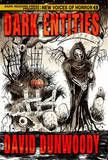 Dark Regions Press / September 2009
Dark Regions Press / September 2009
Reviewed by: Michele Lee
Dark Regions Press kicks off its New Voices of Horror series with a strong – and rotting – foot with this collection of tales from David Dunwoody. It's clear from line one that Dunwoody knows what he's doing when it comes to writing good fiction. Inside these pages we see every kind of savage inhuman monster, from the zombies Dunwoody is known for, to demons, werewolves, and things that have no explanation — even in the horror realm.
Dunwoody clearly has a firm handle on pacing, prose and imagination. If any criticism can be made at all it's that his vision of horror is too close to the brutal and gory approach of Edward Lee and Wrath James White, stylings which can be difficult to handle and which some would argue don’t add to the genre.
But even when Dunwoody uses familiar tropes – such as the popular zombie – the story is far from the median one finds in horror fiction. “Brownlee's Blue Flame”, for example, doesn't bother with the zombie uprising at all, but instead follows Death himself as he learns of the unnatural existence of the undead. In “Sunset”, also a zombie tale, the locale is an exotic and heavenly island filled with people cursed with a devilish hunger for six months out of the year, but the zombie aspect very nearly takes a back seat to the marital problems between the main character and his wife. “The Abbot and The Dragon”, another zombie story, is a mash-up of genres, with a horror ending, a fantasy tone, and a science fiction explanation.
Things aren't perfect in Dark Entities. Dunwoody seems to be exploring his own view of horror as much as readers are there to experience it. There are moments of hesitation in the stories, and Dunwoody does stick to the flashy-gory-violent horror bestiary. But there's a payoff to each story, and an excitement for lovers of all kinds of horror in watching Dunwoody flex his burgeoning literary skill.
Purchase Dark Entities by David Dunwoody.
The Estuary / Derek Gunn
 Permuted Press / June 2009
Permuted Press / June 2009
Reviewed by: Anthony J. Rapino
Derek Gunn, best known for his Vampire Apocalypse series, is back with a new zombie novel, The Estuary. Readers will no doubt discern a more polished novel struggling to surface from beneath Permuted Press’s flawed offering. Had this version been edited perhaps once more, many of the distracting typos and grammatical errors plaguing it would have likely been caught, leaving behind a more refined, superior product.
In 1944, the Nazi’s planned to launch a biological offensive, using a toxic gas held in metal containers as the catalyst. The attack never comes to fruition however, due to a massive storm that destroys the mini-subs carrying the containers. As decades pass, the operation fades from memory.
Flash forward to present day, and we meet John Pender, who has relocated his family to the small town of Whiteshead, Ireland with the hopes of rekindling his failing marriage. His memories of the small town are marred by the realization that a construction crew has dammed the estuary, turning the once beautiful waterway into a dried-out expanse of sand and rock.
While playing on the dried estuary bed, Pender’s son trips over a piece of metal protruding from the ground. Upon word of the strange find, some locals excavate, hoping to find salvage. They uncover one of the aforementioned mini-subs, and upon further exploration witlessly release the toxic gas held within, initiating the zombie apocalypse.
The story progresses as these things usually do: the infected go largely unnoticed until it’s too late, and a cross section of the town’s population becomes zombies. The military appears long enough to quarantine some pedestrians and kill others. In the wake of the murders, quarantine, and roaming undead, survivors band together and try to survive in anyway they can.
Interestingly, the word “zombie” isn’t uttered until page 209, and even then is only mentioned a few times. Initially this omission lends a sense of reality to the novel, but the longer the characters ignore the obvious, the more apparent their ignorance becomes. In the real world, it is unlikely people would jump to the conclusion that the dead have risen. And for this reason, Gunn’s approach is initially appreciated. But once the roaming zombies – complete with fatal injuries – proceed to feast on survivors, even the most level-headed person would find it hard not to refer to the creatures as zombies.
The novel unfolds through the eyes of a diverse cast of characters, and – as if perched atop a mountain – the reader espies every action transpiring below. Gunn does an admirable job of characterization, and although there are many different points of view, the varied characters never become confused. Each character has his or her own perspective, lending to the evolving personalities.
Gunn’s novel, while not without its flaws, is a fun read. The fast pace and substantial gore makes each page a pleasure, and readers will no doubt fall in love with the heroic characters that populate the novel. It is a shame that Permuted Press rushed out this rough version because Derek Gunn, and The Estuary for that matter, deserve better. Here’s hoping readers will have a chance to re-explore the town of Whiteshead in a polished, reprinted version of The Estuary. Until then, the current release will have to satiate those zombie-like literary cravings.
Purchase The Estuary by Derek Gunn.
Chimeric Machines / Lucy A. Snyder
 Creative Guy Publishing / March 2009
Creative Guy Publishing / March 2009
Reviewed by: Martel Sardina
Lucy Snyder’s poetry collection, Chimeric Machines, gets better with every reading. The first pass hits hard. Snyder’s images are stark and disturbing at times, leaving readers devastated by a shared experience of profound pain. Subsequent readings are filled with the joy of discovering the subtlety of her writing style — rhythm and meter, the nuances of Snyder’s word choices, and the way she imprints images in her readers’ minds.
In “And There in the Machine, Virginia Finally Stood Up,” Snyder shows readers one woman’s descent into madness. Throughout her life, Virginia’s accomplishments have been diminished for a myriad of reasons ranging from her gender to her family’s lack of wealth. Nothing she’s done is ever “good enough.” After a lifetime of being beaten down, Virginia finally decides to take matters into her own hands.
The most heart-wrenching poem in the collection is “Babel’s Children,” which Snyder dedicated to the late author/editor, J.N. Williamson. This piece documents a reality that most would care not to see. An author’s estranged sons attend his funeral. Afterward, they destroy their father’s most prized possession. Then they sell his book collection at the local used bookstore. The clerk at the bookstore is happy to find treasures like signed first editions among the items the brothers no longer want. The brothers’ disdain for their father is shown in the final stanza:
Meanwhile, a drunk crematory stiff
dumped the author’s unclaimed ash
However, there is still humor to be found in the darkness. Snyder made this reviewer chuckle more than once. In “Gigantic,” Snyder reveals the unfairness of women’s magazines. Why are they chocked full of delicious desert recipes, yet these treats are only meant to be cooked, not eaten? In “Book Smarts,” Snyder gives readers an alternate use for all those books that are lying around the house.
From the dreamy and fantastic to the bleak and disturbing, Chimeric Machines contains something for everyone in terms of content and style. While readers may not like every piece the first time through, this reviewer challenges you to read Snyder’s work more than once. Find the deeper meaning, and get lost in the landscape that Snyder’s created. You won’t regret it.
Purchase Chimeric Machines by Lucy A. Snyder.




